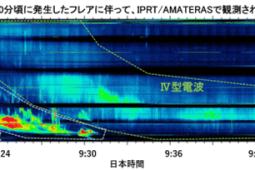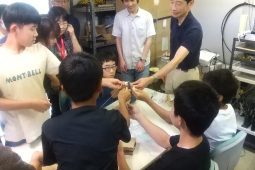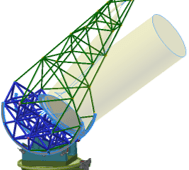PPARCセミナー(2024/09/27)

PPARCセミナー(2024/09/27)
(1) Hajime Ohata,
Test observations of natural lights by the mid-infrared laser
heterodyne spectrometer with the hollow optical fiber coupler
[Abstract]
Mid-infrared (IR) laser heterodyne spectroscopy can achieve an
ultra-high wavelength resolution of λ/dλ > 1,000,000 (frequency
resolution: < 30 MHz) at ~10 μm in wavelength (~30 THz in frequency).
The high dispersion observations for planetary atmosphere enables to
measure wind velocities with a resolution of several 10 m/s and to
detect trace gases including isotopomers. Notable successes for those
targets have been accomplished on Venus, Mars, Jupiter, and Titan, by
ground-based telescopes with heterodyne spectrometers. The
spectrometers used in those observations consist of many optical
elements to combine observed and laser lights. The size and weight
become large, and their optical geometry requires high stability.
Fiber optics can simplify, downsize, and reduce the weight for those
instruments. With this benefit, a near-IR heterodyne system with fiber
couplers has been proposed as a space-borne instrument (Rodin et al.,
2015). On the other hand, in mid-IR, there has been no fiber coupler
with high transmission yet. In this study, we applied a new hollow
optical fiber coupler to mid-IR laser heterodyne spectrometer. The
coupler developed by Toyama University has high transmittance (~61%)
for CO2 laser light. The next step is to utilize them in the
application for natural light measurements.
We evaluated the capability of the mid-IR laser heterodyne
spectrometer with fibers and a fiber coupler for natural lights from
the Sun and black body source. The results are as follows: (1) For the
hollow fiber, the transmission efficiency of 89.6 %/m was achieved for
incoherent natural light from the Sun. (2) Incoherent light from a
black body source and coherent light from CO2 gas laser through fibers
are mixed by a beam splitter. This heterodyne spectroscopy could
achieve a similar sensitivity as the heterodyne instrument without
fibers. (3) Two kinds of incoherent lights and a coherent light from
CO2 gas laser through fibers are mixed by a hollow fiber coupler. The
two lights are from a black body absorbed by a C2H4 gas cell and from
the Sun absorbed by the Earth’s atmosphere. Obtained spectra are
similar to spectra generated by numerical calculation.
Our current heterodyne test system with the fibers and the fiber
coupler showed 10,000K of system noise temperature. It is about 3
times worse than our system without the fiber coupler, indicating that
the test system with the fiber coupler needs an integration time of 9
times longer to achieve the same noise intensity. We are now
justifying the coupling of natural light source to the fiber input,
because the incident angle of observed light from the expected
telescope is larger than the ideal angle for the input of the fiber.
We also report on future works of the master thesis.
(2) Masamichi Waga
TBA
(3) Haruto Yamanaka
Large-scale altitude distribution profile of auroral parallel electric
potentials: A statistical analysis of Cluster data (Soheil Sadeghi, M.
Reza Emami 2019)
[Abstract]
It is generally believed that the heart of the Auroral Acceleration
Region (AAR) is located between 5000 and 8000 km altitude above the
auroral oval. Various altitude distribution profiles are suggested by
different theories, including the transition layer model, which
predicts that the strongest electric fields can be found at about 1
RE, and can vary depending on the plasma and geomagnetic conditions.
However, there have been no specific experimental results that cover
regions both below and well above such altitude. This paper presents a
method for obtaining such a profile from AAR satellite crossings,
applies it to a data set gathered from 116 Cluster spacecraft
encounters with acceleration potential structures, and discusses the
results. The crossings cover an altitude range between 0.63 RE and 2.9
RE. The outcome is the first empirical altitude distribution profile
of the auroral acceleration potentials. The results suggest that the
region within the altitude range of 0.9245 RE and 1.158 RE
statistically contains 30% of the total potential, which is the
largest fraction of the parallel potentials among all altitude
segments of the same size. The altitude which equally divides the
distribution of acceleration potentials was found at 1.076 RE (6863
km). The obtained parallel potential distribution is in agreement with
both the magnetic mirror force theory and the transition layer model,
and can hence provide a proper baseline for future missions to the
AAR.





